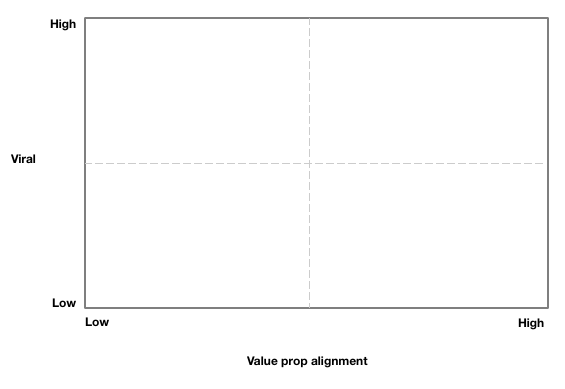Originally asked on Quora. If you find yourself mostly thinking about balancing satisfaction versus virality, you’re probably doing it wrong. The Quora question is a false dilemma, because it asks you to choose between satisfaction and virality, and then quantifying the tradeoff. Most of the time, if you’re working on naturally viral products, you spend most of your time elsewhere. The world of product decisions is more like:
That is, you have features in your product that either drive growth or don’t, and you have features in your product that either really help the value proposition, or don’t. These are actually pretty independent factors and you can build product features that hit each different quadrant. For example, if you are building a product like Skype, finding your friends and sending invites is clearly a high value prop, high virality action. After all, you can’t use Skype by yourself. But if you take the exact same feature, and try to bolt it onto a non-viral product like, say, a travel search engine, then you’re just creating spam. There’s really no great reason to “find friends” in a travel product, though it might be useful to share your itinerary. A feature that’s high-value in one product is spam in the other. And if you think about each quadrant, you get something like this:
- Awesome features grow your product and also people love them. The Skype “find friends” feature is a great one, but so is Quora’s “share to Twitter” feature. After I write this post, I want people to comment and upvote, so something that lets me publish to my audience, which is both viral and part of the value prop is awesome.
- Do it anyway features are just the core of your UX. Writing on walls on Facebook may not be inherently viral in themselves, but it’s important to the product experience, keeps people coming back, and indirectly helps drive the virality of the product. The more people you have coming back, the more changes you have for them to create content or invite people
- Spam features are high virality actions that your users don’t really want to do, and don’t add to the product value prop. I think this is the bucket that the tradeoff lives of a question like, “should I be viral, or offer a great product?” If you are spending a lot of time in this quadrant, then you are shaky ground.
- WTF needs no explanation
Ideally, you want to pick a proven product category that’s naturally viral and high-retention, for instance communication, publishing, payments, photos, etc. – and then spend as much time building awesome features that both drive growth and also make your users happy. Stay away from spam features as much as you can, or use them sparingly lest your product becomes spam.
